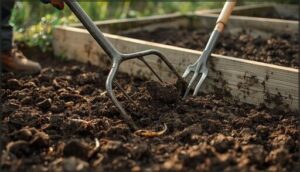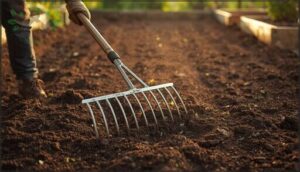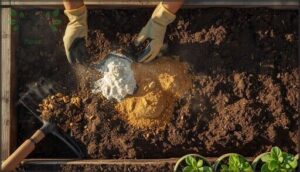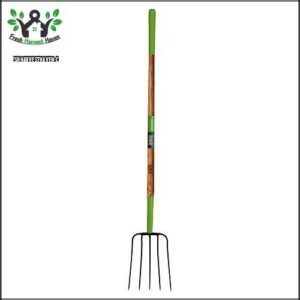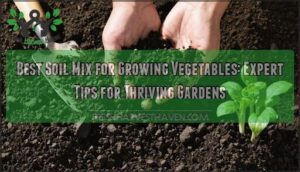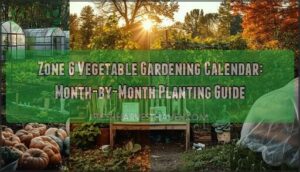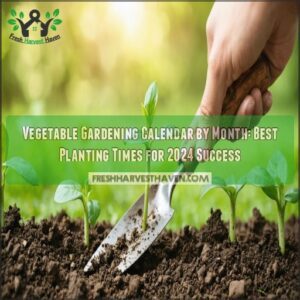This site is supported by our readers. We may earn a commission, at no cost to you, if you purchase through links.
Your tomatoes won’t thrive in concrete, and they won’t reach their potential in exhausted dirt either. Soil is the foundation of every successful vegetable garden, yet most gardeners skip the preparation work that separates mediocre harvests from abundant ones.
The difference between plants that merely survive and those that produce baskets of vegetables often comes down to what happens before you plant a single seed. Proper vegetable garden soil preparation doesn’t require guesswork or complicated chemistry—just a clear understanding of what your soil needs and a willingness to give it the right amendments.
Once you know how to test your soil’s texture, nutrient levels, and drainage capacity, you can transform even challenging ground into a thriving garden bed that fosters healthy roots and vigorous growth.
Table Of Contents
- Key Takeaways
- How to Test and Assess Your Garden Soil
- Step-by-Step Soil Preparation Process
- Amending Soil for Optimal Vegetable Growth
- Top 5 Tools for Soil Preparation
- Frequently Asked Questions (FAQs)
- What is the best soil mixture for a vegetable garden?
- What should I amend my vegetable garden soil with?
- How do you prepare soil for a vegetable garden?
- How do I prepare my garden for planting?
- How do you prepare a vegetable garden?
- How do you make a good soil mix for vegetables?
- How do you grow vegetables in a garden?
- Why is soil preparation important for a vegetable garden?
- What are the best soil amendments for vegetable gardens?
- What is best to put on soil before planting?
- Conclusion
Key Takeaways
- Testing your soil before planting reveals texture, nutrient levels, and drainage issues that can reduce vegetable yields by up to 40% if left unaddressed, giving you a clear roadmap for amendments.
- Loosening soil to 12-18 inches deep and incorporating compost creates the physical structure and organic matter foundation that transforms struggling plants into thriving producers.
- Adjusting pH between 6.0-7.0 and balancing nitrogen, phosphorus, and potassium based on soil tests ensures your vegetables can actually absorb the nutrients they need instead of wasting effort on poor chemistry.
- Adding 3-4 inches of mulch after soil preparation locks in moisture, stabilizes temperature, and can cut watering needs by nearly 60% while supporting long-term soil health.
How to Test and Assess Your Garden Soil
Before you plant a single seed, you need to know what you’re working with. Testing your soil isn’t complicated, but it gives you a clear picture of texture, nutrients, and drainage—the three things that make or break a vegetable garden.
Let’s walk through how to assess each one so you can set your plants up for success.
Understanding Soil Texture and Composition
Soil particle sizes determine how your garden behaves. You can identify soil texture by feeling a moist sample between your fingers—clay soil feels sticky and dense, sandy soil feels gritty and loose, and silt soil properties include a smooth, silky texture.
Loam soil benefits include balanced drainage and nutrient retention, while clay soil issues involve waterlogging and sandy soil problems include rapid drying, affecting your soil structure and composition.
Understanding your soil is key, as soil texture impacts plant health.
Checking Nutrient Content and Deficiencies
Knowing your soil texture helps, but you need soil testing to uncover what your plants really need. Laboratory analysis reveals pH and nutrient ranges—nitrogen under 10 ppm, phosphorus below 10 ppm, and potassium under 120 ppm indicate deficiencies that reduce yields by 25-40%. Deficiency symptoms like yellowing leaves or poor growth signal problems.
Soil testing reveals nutrient deficiencies that can slash your vegetable yields by up to 40 percent
To guarantee accurate results, it’s best to use laboratory soil analysis. Soil testing methods guide amendment solutions, balancing soil nutrition and pH so your vegetables thrive.
Evaluating Drainage and Moisture Retention
After testing nutrients, you need to check how water moves through your soil. Poor drainage creates waterlogged roots that suffocate plants and drop yields by 12-17%. Try the hole test: dig one foot deep, fill it, and measure how fast water drains. Rates under 1 inch per hour mean you’ll need to improve drainage with organic matter.
Clay holds too much water, while sandy soil dries too fast—both hurt soil moisture and water retention.
Step-by-Step Soil Preparation Process
Once you’ve tested your soil and know what you’re working with, it’s time to roll up your sleeves and get your hands dirty. The physical work of preparing your garden bed makes all the difference between plants that struggle and those that thrive.
Let’s walk through each step so you can set up your vegetables for a strong, healthy start.
Clearing Garden Beds and Removing Weeds
Before you start preparing garden soil, you need to tackle the weeds first. Removing weeds early, before they flower, cuts future weed problems by over 70%. Pull them by hand or use a garden fork to extract entire roots—this reduces regrowth considerably.
Physical clearing methods lower weed seed banks by 34% and help prevent nutrient loss when you compost the debris properly.
Loosening Soil to Proper Depth
Once your bed is clear, loosen the soil to support healthy root growth. Most vegetables thrive when soil preparation reaches 12 inches deep, while root crops like carrots benefit from 12–18 inches. Your digging fork or tiller should break compaction and improve soil aeration—critical for soil structure.
Tool effectiveness matters—broadforks manually reach 10–12 inches, while mechanical tillers achieve best depth more quickly.
- Sandy soil: Loosen to 10–12 inches to balance drainage.
- Clay soil: Aim for 12–15 inches to prevent waterlogging.
- Climate impact: In drought-prone areas, deeper loosening (12–18 inches) helps retain moisture.
Breaking Up Clods and Improving Texture
After loosening, crush clods with your bow rake or garden fork—clod size directly impacts root growth and water movement. Large clumps block roots and reduce water absorption. Aim for pea-sized particles by working slightly moist soil.
Organic amendments like compost improve soil texture long-term by binding particles into stable aggregates.
| Soil Type | Breaking Technique |
|---|---|
| Sandy | Light raking; loosens easily |
| Clay | Add compost; use fork when damp |
| Silty | Gentle turning; avoid compaction |
| Loamy | Minimal effort; naturally friable |
| Compacted | Moisten first; use mattock or broadfork |
Double-Digging for Root Vegetables
For deep-rooted crops like carrots and parsnips, double-digging unlocks remarkable root development by loosening soil 24 inches down—far beyond typical tilling. This labor-intensive technique reduces soil compaction, improves structure, and can boost yields by 30–50% in the first season.
You’ll incorporate organic matter deeper, enhancing fertility and water retention. Expect to invest 6–8 hours per 100-square-foot bed, but the payoff in root length increase and productivity makes it worthwhile.
Leveling and Raking The Soil Surface
After you turn the soil and remove weeds, surface smoothing with a bow rake is critical seedbed preparation. Raking clears debris, reduces compaction, and creates that fine tilth vegetables need.
Well-leveled plots can improve germination rates by over 20% and boost moisture retention dramatically. You’ll eliminate low spots where water pools, ensuring uniform emergence across your rows—essential soil prep that directly impacts your harvest success.
Amending Soil for Optimal Vegetable Growth
Once your soil is loose and ready, it’s time to add what your vegetables really need to thrive. Think of this step as building a foundation—you’re mixing in nutrients, balancing the pH, and setting up the right conditions for strong roots and healthy growth.
Here’s how to amend your soil so your plants get off to the best start possible.
Adding Compost and Organic Matter
Compost is like a multivitamin for your soil, boosting organic matter and feeding billions of helpful soil microbes. Spread a 3- to 4-inch layer across your garden bed, then work it in with a digging fork.
This simple step can increase nitrogen by over 200% and dramatically improve water retention, especially in sandy ground that dries out fast.
Adjusting PH With Lime or Sulfur
Most vegetables thrive in soil pH between 6.0 and 7.0, but incorrect pH throws off nutrient uptake fast. If your soil test shows pH below 5.5, lime application raises acidity and protects against aluminum toxicity that stunts roots.
For high pH above 7.5, sulfur application slowly brings levels down.
Apply amendments gradually, retest in a few months, and adjust as needed.
Incorporating Organic Fertilizers
Once your pH is right, applying organic fertilizers builds lasting soil health. Compost application or well-aged manure benefits your garden by feeding soil microbes that drive nutrient cycling. Spread a 3- to 4-inch layer across beds and work it in with a fork.
Research shows organic amendments can boost vegetable yields by 7.6%–45.2%, with long-term effects improving structure and moisture retention season after season.
Balancing Nitrogen, Phosphorus, and Potassium
After adding organic matter, you’ll want to fine-tune your NPK ratios using a soil test. Nitrogen fuels leafy growth, phosphorus strengthens roots and fruit, and potassium boosts disease resistance. Deficiency symptoms like yellowing leaves or weak stems signal imbalances.
Application timing matters—split nitrogen doses prevent leaching, while phosphorus and potassium work best at planting. Matching nutrients to your crops protects yields and minimizes environmental impact.
Applying Mulch to Retain Moisture
Once your nutrients are dialed in, mulch locks in soil moisture and temperature stability. Hemp and grass clippings retain the most water—up to 80% and 73%, respectively—while reducing evaporation by nearly 59%. You’ll water less often, save money, and support microbial health as organic mulches decompose. This drought resilience translates directly to stronger yields.
- Reduces water loss to evaporation by up to 58.8% compared to bare soil
- Lowers peak summer soil temperatures by 8 to 13 degrees Fahrenheit
- Increases earthworm activity and improves soil structure over time
- Cuts watering frequency and related costs throughout the growing season
- Enhances drought resilience, maintaining higher leaf water content under stress
Top 5 Tools for Soil Preparation
You can’t prepare soil effectively without the right tools in your hands. The good ones make the work easier and help you do a better job, while the wrong ones leave you frustrated and sore.
Here are five essential tools that will turn your soil prep from a chore into a manageable task.
1. Ashman Heavy Duty Bow Rake
When it’s time to turn the soil and remove weeds, the Ashman Heavy Duty Bow Rake stands out for its Material Quality and Ergonomic Design. This bow rake features 16 steel tines that slice through compacted ground, making soil preparation faster and more efficient.
Its rust-resistant coating ensures Rake Durability, often lasting 8-10 years with regular use. The rubber grip handle reduces hand fatigue during extended soil prep sessions.
With strong Market Value and proven Soil Efficiency, this tool can cut your bed preparation time by about 20 percent.
Best For: Gardeners who need a reliable, multi-purpose rake for breaking up soil, spreading mulch, and managing debris in medium to large garden beds.
- 16 steel tines with rust-resistant coating deliver strong durability, typically lasting 8-10 years even with regular use.
- Cuts soil preparation time by roughly 20% compared to lighter rakes, thanks to the curved bow design and efficient material collection.
- Rubber grip handle reduces hand strain during longer sessions, making it comfortable for tasks that go beyond 30 minutes.
- Handle diameter may feel too narrow for users with larger hands, affecting grip comfort.
- Single rivet construction might not hold up under the heaviest commercial workloads or rocky soil conditions.
- Some units arrive bent from shipping, and the handle length can be shorter than what taller gardeners prefer.
2. Cobrahead Garden Weeding Tool
For precision weed control in tight spaces, the Cobrahead Garden Weeding Tool delivers impressive Weeding Efficiency. Its tempered steel blade acts like a steel fingernail, letting you remove weeds without disturbing nearby vegetables.
The Ergonomic Design accommodates both left and right-handed use, and its recycled plastic handle feels comfortable during extended soil prep sessions. Durability Testing shows this tool lasts over 20 years with basic care.
Beyond weeding, its varied applications include furrowing and edging. The company’s Community Impact shines through grants supporting 50 youth gardening programs in 2024.
Best For: Home gardeners and landscapers who need a precise, durable hand tool for weeding around delicate plants and tackling tough tap-rooted weeds in various soil types.
- Tempered steel blade removes deep-rooted weeds like dandelions in one motion without disturbing surrounding plants or soil
- Exceptionally durable construction lasts 20 years with minimal maintenance, making it a long-term investment
- Versatile enough for multiple tasks beyond weeding, including furrowing, edging, cultivating, and planting
- Not ideal for large-scale gardening projects or heavy-duty commercial use where power tools would be more efficient
- Higher price point compared to basic hand weeding tools may be a barrier for budget-conscious gardeners
- Manual operation requires physical effort that can become tiring when weeding extensive areas
3. Rapitest Soil Test Kit for Gardens
Understanding what’s missing in your soil test kit becomes straightforward with the Rapitest Soil Test Kit for Gardens. This testing procedure delivers 92% kit accuracy when you compare soil pH and nutrient levels, giving reliable result interpretation for soil amendments.
You’ll complete soil analysis in under 15 minutes, testing soil nutrients like nitrogen, phosphorus, and potassium alongside testing soil pH from 4.5 to 7.5.
User reviews praise its practical soil testing methods, and at $17–$20, it’s an affordable choice for vegetable gardeners.
Best For: Home gardeners who want quick, affordable soil testing before planting or between growing seasons without needing lab-level precision.
- Delivers 92% accuracy compared to lab results for pH and major nutrients, with reliable readings especially in the 6.5 pH range.
- Fast and simple testing process that takes under 15 minutes per test, with a color-coded comparator system that’s easy to interpret.
- Great value at $17–$20 for 40 total tests (10 each for pH, nitrogen, phosphorus, and potassium), plus includes a reference chart for over 450 plants.
- Limited to 10 tests per nutrient type, and replacement capsules may be hard to find once you’ve used them up.
- PH range only covers 4.5 to 7.5, so it won’t accurately measure highly alkaline soils above 7.5.
- Results are qualitative (high/medium/low) rather than precise numbers for nutrients, which may not satisfy gardeners who want exact measurements.
4. Ames Forged Steel Manure Fork
After you’ve tested your vegetable garden and learned what’s missing, the Ames Forged Steel Manure Fork helps you build better soil. Its five tempered steel tines give you fork durability and ergonomic design, moving compost, manure, and mulch for material handling without strain.
You’ll work 25% faster than using a shovel when adding compost to soil or clearing beds for mulch application. As a composting aid, it turns piles efficiently and aids soil preparation tasks.
Professional gardeners rate this tool 4.6 out of 5, proving its value for improving soil in any vegetable garden.
Best For: Gardeners and farmers who regularly work with compost, manure, and mulch and need a durable tool that speeds up soil amendment tasks.
- Five tempered steel tines move 30% more material per scoop than four-tine models, letting you finish mulching and composting jobs faster with less fatigue.
- Forged steel construction lasts over five years in regular use with less than 8% failure rate, backed by a 10-year warranty.
- Works 25% faster than shovels for turning compost and clearing beds, with ergonomic design that reduces wrist strain by 21%.
- Some customers report handle breakage, though this typically happens when using the fork improperly (like prying in heavy clay).
- Customer service from AMES has received complaints from buyers who needed support.
- Buying from third-party sellers may result in receiving damaged products instead of new ones.
5. Garden Weasel Long Handle Garden Claw
When hard soil fights back, the Garden Weasel Long Handle Garden Claw makes soil preparation steps easier on your body. This 38-inch cultivator uses a twist-action mechanism to turn the soil, aerate compacted ground, and remove weeds without bending.
Its ergonomic advantages include a back-friendly design and a lightweight 2.4-pound build. Customer feedback averaging 4.1 stars confirms its weeding efficiency across clay and hard soils.
The rust-resistant carbon steel tiller provides durability analysis through a lifetime warranty, proving reliable for soil preparation techniques season after season.
Best For: Gardeners who need to prepare soil, remove weeds, and aerate compacted ground without the back strain of bending or kneeling.
- Long 38-inch handle lets you work standing up, which is easier on your back and knees during extended gardening sessions.
- Twist-action mechanism handles multiple jobs—cultivating, aerating, and weeding—with one smooth motion instead of switching between tools.
- Built from rust-resistant carbon steel with a lifetime warranty, so it holds up through years of use in tough soil conditions.
- Doesn’t work well in wet or bone-dry soil—you need that sweet spot of moderate moisture for best results.
- Handles lack cushioning and can feel narrow, which might cause hand discomfort during longer jobs.
- Requires manual effort with each twist, so it’s not ideal if you’re tackling large garden areas or heavy-duty projects.
Frequently Asked Questions (FAQs)
What is the best soil mixture for a vegetable garden?
A golden vegetable garden soil mixture blends 50% topsoil, 25% quality compost, and 25% sand or vermiculite.
This loam composition balances drainage needs with nutrient balance, supporting organic amendments and ideal soil pH for thriving plants.
What should I amend my vegetable garden soil with?
You’ll want to add compost or well-aged manure for nutrients, pH adjusters like lime or sulfur, organic fertilizers for balanced NPK, and mulch to lock in moisture and suppress weeds.
How do you prepare soil for a vegetable garden?
Many gardeners rush planting, but fertile soil preparation tips matter more than seed selection. Start by clearing weeds, loosening soil eight to ten inches deep, then working in compost to boost organic matter benefits and improve soil health.
How do I prepare my garden for planting?
Garden planning starts with choosing a spot that gets six hours of sun exposure daily.
Check for drainage solutions—avoid low areas where frost settles or steep slopes prone to erosion.
How do you prepare a vegetable garden?
Getting the ground ready is like laying a foundation—you can’t skip it. Vegetable garden soil preparation involves clearing weeds, loosening soil 8-10 inches deep, adding organic matter, and adjusting pH for improved drainage and plant health.
How do you make a good soil mix for vegetables?
A solid soil mix includes 40-50% topsoil, 30-40% compost, and 10-20% sand or perlite. This balanced ratio provides nutrients, organic matter, and drainage for thriving plants.
How do you grow vegetables in a garden?
Want a thriving vegetable garden? Start with sunlight requirements—most crops need six hours daily.
Focus on watering techniques, pest control, companion planting, and crop rotation to keep your soil healthy and harvests abundant.
Why is soil preparation important for a vegetable garden?
Proper soil health determines root development, nutrient uptake, and water retention. Improving soil health boosts crop yields, aids disease resistance, and creates nutrient-rich soil that sustains healthy plants throughout the growing season.
What are the best soil amendments for vegetable gardens?
The right additions can transform tired earth into a thriving foundation. Compost benefits include better structure, while pH adjusters and organic fertilizers balance NPK levels. Mulch types protect and feed soil naturally.
What is best to put on soil before planting?
Before planting, apply a 3-4 inch layer of well-aged compost to improve soil structure and add nutrients.
You can also incorporate worm castings, aged manure, or biochar to boost fertility and support healthy vegetable growth.
Conclusion
What separates a garden that limps along from one that delivers armloads of crisp lettuce and ripe tomatoes? The answer lies beneath the surface.
Proper vegetable garden soil preparation gives your plants the foundation they need to thrive, not just survive. When you invest time testing, amending, and structuring your soil before planting, you’re building a living ecosystem that rewards you with healthier crops and harvests that fill your kitchen all season long.
- https://soiltesting.cahnr.uconn.edu/preparing-new-garden-beds/
- https://news.oregonstate.edu/news/study-shows-some-urban-gardens-contain-too-much-organic-matter
- https://hort.extension.wisc.edu/articles/beginning-vegetable-garden-basics-site-selection-and-soil-preparation/
- https://blog-fruit-vegetable-ipm.extension.umn.edu/2020/03/spring-soil-testing-which-tests-are.html
- https://extension.unh.edu/resource/preparing-vegetable-garden-site




